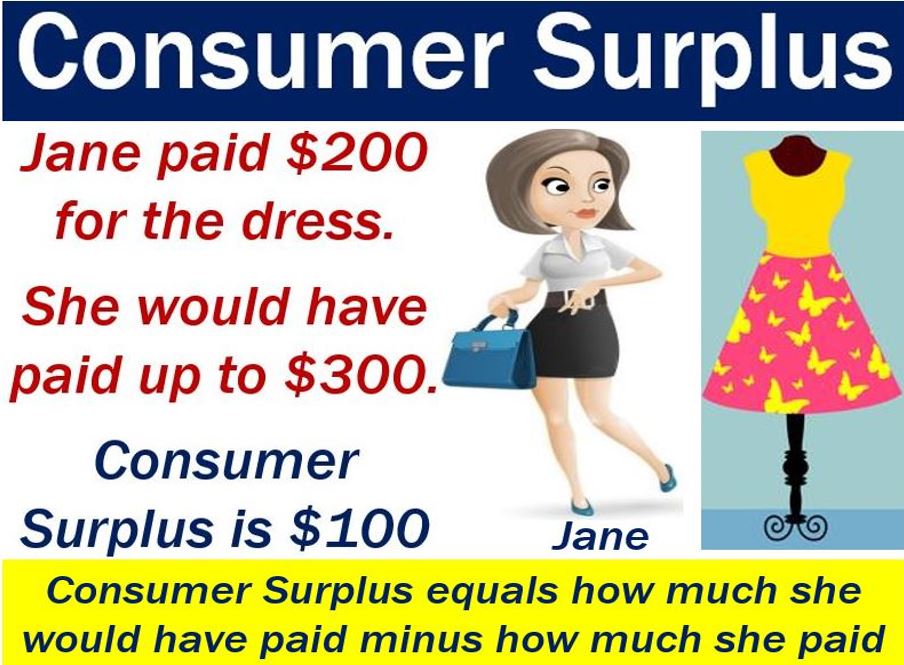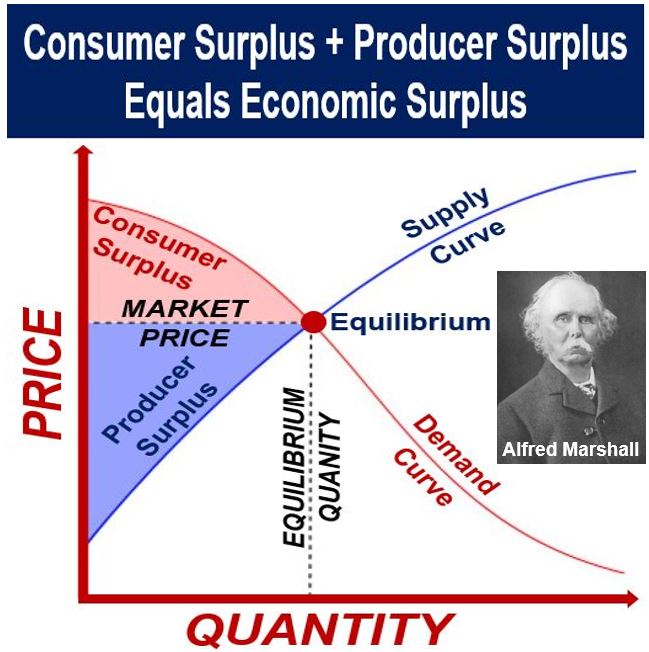Consumer surplus – definition and meaning
Consumer Surplus is the difference between how much consumers paid for a product or service and how much they would be willing to pay. How much they paid is the ‘market price.’ How much they would be willing to pay is their ‘maximum acceptable purchase price.’
Consumer surplus and product surplus are the two quantities included in the Economic Surplus. Economic surplus is the combination of consumer and producer surpluses.
The producer surplus is the difference between how much a supplier sold an item for and how cheaply they would have sold it for.
Consumer surplus on a graph
Consumer surplus is a measure of the welfare that individuals gain from consuming products. On a supply and demand graph, consumer surplus is the area above the price and below the demand curve.
The producer surplus, on the other hand, is the area below the market price and above the supply curve.
According to the Economist’s glossary of terms, consumer surplus is:
“The difference between what a consumer would be willing to pay for a good or service and what that consumer actually has to pay. Added to producer surplus, it provides a measure of the total economic benefit of a sale.”

Consumer surplus & price elasticity of demand
Price elasticity of demand is a measure of how the change in price affects the demand for a product.
Demand for a very price elastic product changes by more than the change in its price. For example, let’s suppose the price of luxury cruises goes up by 5% and demand falls by 10%. Therefore, luxury cruises are very price elastic.
However, price change does not affect demand for price inelastic products. If the price of bread goes up by 5%, demand is unlikely to decline anywhere near 5%, if at all.
Perfectly elastic, inelastic demand
When demand for a product is perfectly elastic, consumer surplus is zero. It is zero because the price that consumers pay is the same as the maximum amount they would be willing to pay.
In other words, their highest acceptable purchasing price equals the market price.
When demand for a product is perfectly inelastic, on the other hand, consumer surplus is infinite. Whatever the price, demand remains the same.
When demand for a product is inelastic, there is more potential for consumer surplus. There will be some shoppers who are willing to pay a high price to continue buying the product.
Companies commonly raise prices when demand is inelastic. They raise prices so that the consumer surplus can be turned into producer surplus. If suppliers raise their price, the difference between their minimum selling price and how much they sell something for gets bigger.

In this chart, the Consumer Surplus is the pink area above the market price and below the demand curve. The Producer Surplus is the blue area below the market price and above the supply curve. The equilibrium quantity is equal to both the demand quantity and the supply quantity simultaneously. The market price is the amount consumers paid, and producers received for each item. Alfred Marshall formalized these ‘surplus’ terms in 1890. (Image: Adapted from Wikipedia)
Consumer surplus – drinking water
As we now know, consumer surplus is the difference between the consumers’ highest acceptable price and how much they paid.
So, what happens when consumers are unwilling to pay more than the market price? They get more benefit from the product they bought than they initially paid.
Take, for example, drinking water. Drinking water has a high consumer surplus. If we need water to survive, we will pay whatever it takes to stay alive.
The difference in how much consumers would pay and the amount that they currently pay is their consumer surplus.
The utility of the first bottle of drinking water for somebody who is dying of thirst is extremely high. It is high because it prevents death.
Therefore, the first liter of drinking water somebody bought would have more consumer surplus than subsequent purchases.
The scarcity or abundance of a product significantly influences consumer surplus, as rare or essential items like life-saving medicines often have a higher consumer surplus due to their critical nature.
In contrast, unique or highly differentiated products, such as luxury goods or innovative technologies, can also command a high consumer surplus, as consumers may be willing to pay premium prices for their distinct attributes or perceived value.
If I were dying of thirst, I’d pay all the money I could get my hands on. In fact, I would even pay $10,000, for a liter of water. I’d pay less for the second and third liter.
However, if I were not dying of thirst, paying $10,000 would be out of the question.
Compound phrases with surplus
There are many compound phrases in the English language with the term ‘surplus’ apart from consumer surplus. Here are the five most common ones (please make definitions as brief as possible):
The difference between the amount a producer receives for an item and the minimum amount they would have accepted.
-
Budget Surplus
When a government’s income exceeds its expenditures during a specific period.
Occurs when a country exports more than it imports.
The sum of consumer surplus and producer surplus in an economy.
-
Resource Surplus
An abundance of resources beyond what is needed or utilized.
Video – What is a surplus
This video, from our YouTube partner channel – Marketing Business Network, explains what ‘Surplus’ means using simple and easy-to-understand language and examples.

